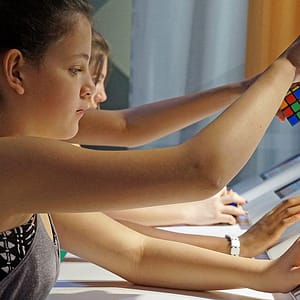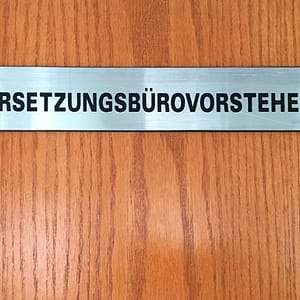Creating Multilingual Exhibit Labels
Look at the Big Picture.
- Multilingual labels must work in conjunction with the rest of your exhibition graphics, such as flyers, banners, advertising, web content, and multimedia components. Maintain a cohesive approach that will pull it all together.
Design for Readability.
- Always use clear, legible fonts.
- Text should be large enough that everyone can read it – even when the exhibition draws a crowd.
- Select your colors wisely. High contrast between text and background increases readability.
Make Non-English Languages Easy to Find.
- Be consistent in your placement of languages so visitors can easily find their preferred language.
- Displaying languages side by side is a widely-used approach to engage bilingual visitors, as it enables readers to jump back and forth as they feel comfortable.
- Some museums use different colors to make it easier for the visitor to spot the language of their choice. Use color in a way that makes sense with your overall design strategy.
Get in Touch!
Reach out to discuss your next translation project with a member of our team.
Don’t Play Favorites.
- Do not give the impression that one language is more important than another. Use an equitable design that presents both languages with equal visual weight.
- Be aware that some languages require more space than others. For example, an English-to-Spanish translation may be at least 20% longer in Spanish. Text may require slight modification to give languages equal space on your labels.
Translate for Your Audience.
- When you begin translation, make sure to give your translation provider any reference materials that might help them better understand the nuances of the content to be translated.
- Translation for signage does not need to be 100% literal. Adapt the text for the target audience, while maintaining a consistent style, tone, and message. Change any cultural references that might not resonate with an international audience (for example, an item the “size of a baseball” might be changed to the “size of a cricket ball”).
Featured Services
Learn more about…
Maintain Consistency.
- If your exhibition uses specialized terminology, create a glossary at the start of the project and maintain it as a live document to ensure consistent usage of key terminology.
- Set up style guidelines that will be used throughout your organization. For example, many art museums prefer to keep artwork titles in the original language, as they feel it best represents the artist’s intent. Whatever approach you choose, be consistent!
Be Flexible and Creative.
- Developing a bilingual exhibit is not a simple process. Start the process early. Expect some back and forth between writers, designers, the translation team, and other invested parties. Sometimes translators raise interesting questions that help add greater clarity to a description. In the end, promoting a collaborative process will produce a more thoughtful, well-developed outcome.
 Named to the 2024 Inc. 5000 list of fastest-growing companies and ranked among the world’s top 100 language service providers by CSA Research
Named to the 2024 Inc. 5000 list of fastest-growing companies and ranked among the world’s top 100 language service providers by CSA Research

